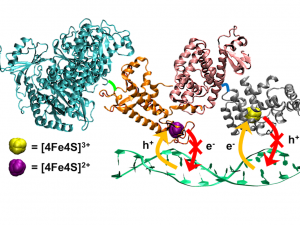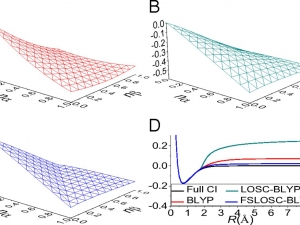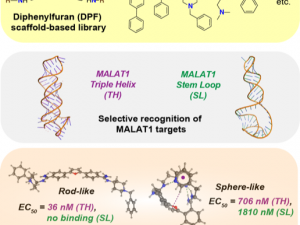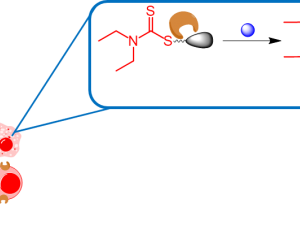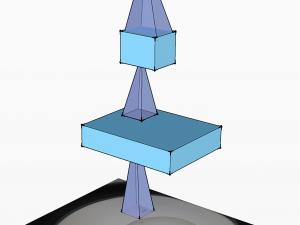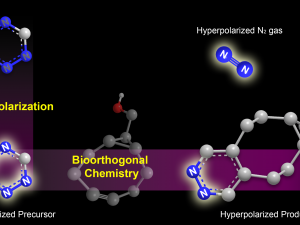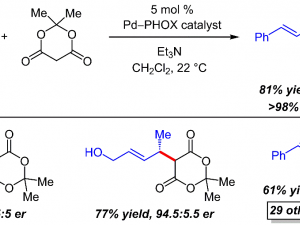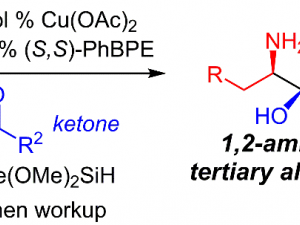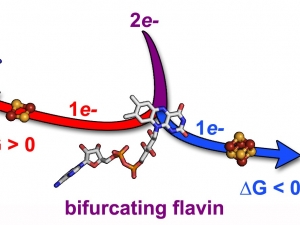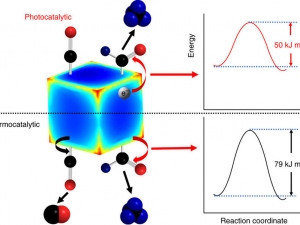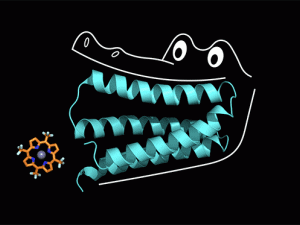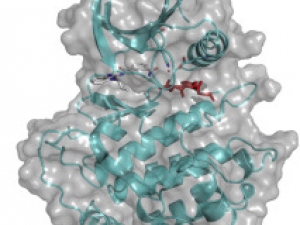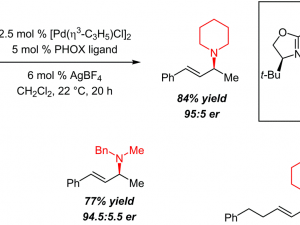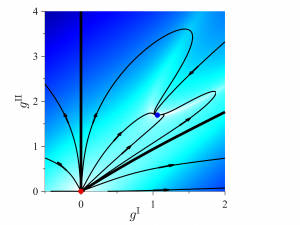Graduate student Meredith Barbee and co-workers in the Craig lab and at Texas State have used a mixture of classical physical organic methodology and contemporary single molecule spectroscopy to tease out mechanistic details of a reaction occurring under large mechanical forces. Their paper in JACS has been highlighted by the journal here. read more about Reaction Mechanisms in Single Molecule Mechanochemistry »
Agostino Migliore, Darius Teo and additional members of the Beratan Lab, with collaborators at USC, take an important step towards understanding intracellular redox signaling at the core of DNA repair and replication processes. Experiments suggesting a role for DNA charge transport in mediating such signaling have been the subject of a heated debated in recent literature. The lab has demonstrated that charge transfer between a [4Fe4S] protein and a nucleic acid duplex is unidirectional. This… read more about Unraveling Important Constraints on the Mechanisms for Redox Signaling in DNA Replication and Repair »
The static correlation error inherent in commonly used density functional approximations (DFAs) has seriously hindered the application of density functional theory (DFT) to strongly correlated systems. Here, an effective fractional-spin correction against the important issue of static/strong correlation in DFT is developed. With this, the flat-plane behavior of various DFAs is largely restored, and the potential energy curves of dissociation of ionic species, single bonds, and multiple bonds are properly described, which… read more about Yang Lab Describing Correlation with Fractional-spin Correction in DFT »
While the majority of small molecule chemical probes and drugs to date modulate the action of proteins, the Hargrove Lab is searching for small molecules that selectively engage binding pockets of RNA. In their most recent work, the group discovered the first ligands for the triple helix structure of an oncogenic long non-coding RNA MALAT1. The synthesis, evaluation and computational analysis of these novel small molecules revealed trends between small molecule shapes and their binding behavior. Together, these… read more about Hargrove Lab Searches for Small Molecules that Selectively Engage Binding Pockets of RNA »
The enantioselective and intermolecular addition of nucleophiles to internal olefins is a challenging process due to the typically low reactivity of these substrates. Hydroaminations of 1,4-disubstituted dienes present further challenges as several product regioisomers may be obtained and reactions tend to be reversible, leading to erosion of enantiopurity of products over time. The Malcolmson lab has now demonstrated that Pd–PHOX catalysts facilitate the regio- and enantioselective hydroamination of internal dienes with… read more about Malcolmson Lab Illustrates Enantioselective Hydroamination of Internal Dienes »
Non-coding RNAs have been identified that are essential for cellular regulation and that are misregulated in disease; however, the development of tools to study these RNAs has been challenging. To harness existing knowledge into the development of RNA-targeted chemical probes, the Hargrove lab examined the RNA targets, design and discovery strategies, and characterization techniques for ligands in the RNA-targeted BIoactive ligaNd Database (R-BIND). Further, the survey… read more about Hargrove Lab Hopes to Expedite the Discovery of RNA-targeted Ligands »
GGTDTC, a copper prochelator of dithiocarbamate was developed to release dithiocarbamate (DTC) in cancer expressing gamma-glutamyl transferase enzyme. Upon release DTC is free to bind to Cu to form toxic Cu(DTC)2 . GGTDTC was found to selectively release diethyldithiocarbamate only in prostate cancer cells with measurable gamma-glutamyl transferase activity. These findings underscore a new strategy to leverage the amplified copper metabolism of prostate cancer by conditional activation of a metal‐binding… read more about Franz Lab Combating Prostate Cancer One Metal at a Time »
The Charbonneau lab is bringing together researchers from industry and academia to develop a tool for automatizing protein crystal recognition. Scientists came together to collect half a million images of protein crystallization experiments into a database that can specify which of these protein cocktails led to crystallization, based on human evaluation. The team then worked with a group led by Vincent Vanhoucke from Google Brain to apply the latest in artificial intelligence to help identify crystals in… read more about Charbonneau Lab Using A.I. to Recognize Crystals in Protein Crystallization Experiments »
Building upon their initial work illustrating the use of 2-azadienes for the enantioselective synthesis of challenging amine scaffolds, the Malcolmson lab has now reported that these reagents may engage in reductive couplings with imines for the synthesis of anti-1,2-diamines. The Cu-catalyzed process is highly chemo-, diastereo-, and enantioselective for the preparation of a range of diamines, including those that have largely remained elusive until now. The authors additionally highlight the… read more about Malcolmson Lab Demonstrates Reductive Coupling Strategy for 1,2-Diamine Synthesis »
The Derbyshire Lab is attempting to target the Malaria-causing parasite, Plasmodium, in the liver before it can reach the red blood cells. In their recent PLOS Pathogen publication, available here, Derbyshire lab members use an inhibitor to curtail the parasite’s ability to reproduce inside the liver. Read more about their study in the Duke Today highlight! read more about Derbyshire Lab Targets Malaria Parasite in the Liver »
The collaborative efforts of the Derbyshire and Haystead labs reveal that compounds that bind to Hsp90 represent a class of molecules that inhibit both blood- and liver-stage Plasmodium parasites. This dual-stage inhibition is ideal for antimalarials, and their work highlights the potential of Hsp90 inhibitors as drug partners in combination therapies. Read more about this research in an April issue of Antimicrobial Agents and Chemotherapy article here. read more about Derbyshire Lab Finds Hsp90 Inhibitors That May Aid in Treating Malaria »
The Franz Lab and collaborators explored the antibacterial mechanism of PcephPT, a prodrug of the antimicrobial chelator pyrithione. Graduate students Jacqueline Zaengle-Barone and Abigail Jackson and former grad student David Besse found that PcephPT has an unconventional mode of action, requiring β-lactamase expression and copper availability for maximal activity. This “prochelator" overcomes the liability of metal chelation toxicity because it does not chelate metal ions until specifically… read more about Franz Lab Demonstrates Copper’s Role in Antibacterial Mechanism of a Prochelator »
A Departmental Collaboration is lighting up MRIs! Junu Bae of the Wang Lab and Zijian Zhou of the Warren Lab have developed chemical tags that attach to molecules, making them light up under MRI! Read more about these tags and how they could change how drugs target illness in the Wang/Warren lab article available in the March 9 publication of Science Advances. read more about Wang and Warren Collaboration Report a Novel Hyperpolarization Tagging Strategy »
Professors David Beratan and Peng Zhang, with collaborators at NYU and ASU, have designed, built, and demonstrated current splitters and charge-transport junctions based on self-assembling nucleic acids. These constructs promise to expand the functionality of self-assembling bio-inspired electronic devices at the nanoscale. Learn more about their design from Arizona State's Biodesign Center for Bioelectronics & Biosensors or read more in the February 26 issue of Nature Nanotechnology!… read more about Charge Splitters and Charge Transport Junctions Based on Guanine Quadruplexes »
The Malcolmson lab has demonstrated that olefins may act as alkylating agents for the enantioselective intermolecular addition of enol-type nucleophiles under Pd catalysis. Typically, polarized electrophiles are required for couplings with enolates/enols or their equivalents, reducing atom economy and potentially functional group tolerance. In this work, Prof. Malcolmson, graduate student Nathan Adamson, and undergraduate Katie Wilbur show that activated pronucleophiles undergo enantioselective addition to a variety of… read more about Malcolmson Lab Illustrates Olefins as Alkylating Agents for Enantioselective Synthesis »
The high temperatures and intense UV irradiation of the early earth made DNA particularly susceptible to damage. Beratan’s group used theory, modeling, and simulation to explore the mechanism of photochemical repair of damaged DNA by the enzyme photolyases. The group focused on the critical (and much debated) photo-induced electron-transfer reaction that leads to DNA repair. The group resolved a long-standing debate on the role of adenine in the repair, and found that thermophilic and hyperthermophilic DNA photolyases… read more about Beratan Group Sheds Light on DNA Repair »
The de novo design of a protein capable of binding a cofactor in a unique orientation is a challenging problem because a range of structurally similar, yet different, complexes are often formed. Now, a team led by former graduate student Nick Polizzi and by Professors David N. Beratan and Michael J. Therien at Duke, and by Professor William F. DeGrado at UCSF, report a protein — designed entirely from first principles — that binds a small-molecule cofactor in a unique and precisely predetermined… read more about Beratan, Therien and Collaborators Pack a Porphyrin into a Protein Puzzle »
The Malcolmson lab has reported a new class of reagents, 2-azadienes, for the catalytic enantioselective construction of chiral amines. The 2-azadienes demonstrate reverse polarity (umpolung) of an enamine, facilitating catalytic addition of a nucleophile to its N-b-carbon and subsequent stereoselective electrophile trap at the a-carbon. In this work, they illustrate the power of these reagents in reductive couplings with ketones for chemo-, diastereo-, and enantioselective preparation of 1,2-amino tertiary… read more about Malcolmson Lab Discloses New Reagent for Enantioselective Amine Synthesis »
Biology is well known to manipulate energy using proton-coupled electron transfer and phosphorylation reactions. It was found recently that energy conversion can also occur via a new class of reactions, known as electron bifurcation reactions. Remarkably, these reactions send one electron “uphill” and one “downhill,” enabling the overall reaction to satisfy the demands of thermodynamics. Jonathon Yuly, a graduate student working with Profs. Zhang and Beratan in the… read more about Beratan Group Explains New Class of Electron Bifurcation Reactions »
The Wang, Malcolmson and Warren labs have teamed up to use diazirines as molecular imaging tags for biomedical applications. Diazirines are an attractive class of potential molecular tags for magnetic resonance imaging with their biocompatibility and ease of incorporation into a large variety of molecules. The team has recently demonstrated with a 15N2-diazirine-containing choline derivative that 15N2-diazirines are capable of supporting long-lasting polarization, … read more about Wang, Malcolmson and Warren Labs Promoting Hyperpolarization of 15N2-Diazirines for Novel NMR/MR Imaging Strategies »
Equilibrating glass-forming liquids is notoriously hard; Duke chemists and their collaborators in France have developed a way to circumvent this obstacle, enabling studies of extremely sluggish liquids. The results were just published in Proceedings the National Academy of Sciences and Physical Review Letters. The latter paper was also featured in Physics Synopsis and you can learn more on the Duke Research Blog. read more about Charbonneau Lab and Collaborators Cheat Time »
A recent publication in Nature Communications on selective carbon dioxide hydrogenation using plasmonic rhodium catalysts by the Liu lab and collaborators has been selected as one of eight featured articles in the Nature Research “Understanding Catalysis” collection. In preparation for the launch of Nature Catalysis, a new online-only journal in the Nature family, this specially curated collection brings together recent work that offer new understandings into… read more about Recent Liu Lab Work Selected for Nature Research “Understanding Catalysis” Collection »
The Hargrove Lab compared bioactive ligands that target RNA to current FDA-approved drugs, nearly all of which target proteins. With the help of the Beratan Lab, they identified key differences in physical, structural, and spatial properties that distinguish RNA-targeted bioactive ligands. These unique insights are expected to facilitate the selection and synthesis of RNA-targeted libraries with the goal of efficiently identifying selective small molecule ligands for therapeutically relevant RNAs. Read more about… read more about Hargrove Lab Discovers Distinctive Properties of RNA-targeted Chemical Probes »
The Therien Lab, teamed with chemists at UC San Francisco, have created a synthetic protein that tightly binds a non-biological catalyst, a type of molecule called porphyrin that is capable of stealing electrons from other molecules when it absorbs light. Read more about how the “protein gator” chomps porphyrin cofactors in the Nature Chemistry article available here. read more about Therien Lab Solving Protein Design Puzzle One Chomp at a Time »
A recent molecule, Takinib, developed by the Derbyshire and Haystead's labs, has been found to induce cell death in cancer cells by inhibiting the enzyme TAK-1. Current testing is focused on Takinib’s possible therapeutic benefits in rheumatoid arthritis and could potentially expand to focus on other diseases, such as malaria. Read more about this exciting molecule in the recent edition of Cell Chemical Biology. read more about Derbyshire Lab and Pharmacology Collaborators Spur Cell Death in Tumors »
The Welsher Lab has created a 3D Virus Cam that can track particles that are faster moving and less bright than previous microscopes. This new development provides a robust method for real-time 3D tracking of fast and lowly emitting particles, based on a single excitation and detection pathway, paving the way to more widespread application to relevant biological problems. Learn more about the Welsher Lab's "virus camera" in the recent issue of Optics Letters, available here or watch as it… read more about Welsher Lab Builds 3D Virus Camera »
The development of reactions that transform cheap and readily accessible materials to high-value products with minimal waste is an important objective in chemical synthesis. Enantioselective intermolecular olefin hydrofunctionalizations meet these criteria but are rare. The Malcolmson lab has reported the first examples of late transition metal-catalyzed enantioselective intermolecular hydroamination of olefins with aliphatic amines. A range of acyclic 1,3-dienes undergo reaction with several amines in the… read more about Malcolmson Lab Reports Catalytic Enantioselective Intermolecular Hydroamination »
The transformation of the free-energy landscape from smooth to hierarchical in glassy materials can significantly impact their low-temperature properties. With 30 pages of handwritten calculations Sho Yaida, a Duke postdoctoral fellow in the Charbonneau lab, has laid to rest a 30-year-old mystery about the nature of this transformation. The work was just published in Physical Review Letters. Learn more on Duke TODAY. read more about 30-year-old Mystery on the Glass Problem Demystified »
A cartilage-mimicking material created by the Wiley Lab may one day allow surgeons to 3-D print replacement knee parts that are custom-shaped to each patient’s anatomy. Feichen Yang, a graduate student in the Wiley lab, experimented with mixing together two different types of hydrogels -- one stiffer and stronger, and the other softer and stretchier -- to create what is called a double-network hydrogel. By changing the relative amounts of the two hydrogels, Yang could adjust the strength and elasticity of… read more about Printable Hydrogel Matches the Strength and Elasticity of Human Cartilage »
The reliance on heated catalysts to overcome high activation energies and achieve practical reaction rates in industrial scale catalysis not only requires high thermal energy inputs but also shortens catalyst lifetime. By comparing light and dark conditions on rhodium catalysts in carbon dioxide hydrogenation, the Liu lab, together with Dr. Henry Everitt at the Army Aviation & Missile RD&E Center and Yang group in our department, has shown how the plasmonic behavior of rhodium nanoparticles profoundly improves their… read more about Lighting the Path Towards Selective Carbon Dioxide Hydrogenation »


